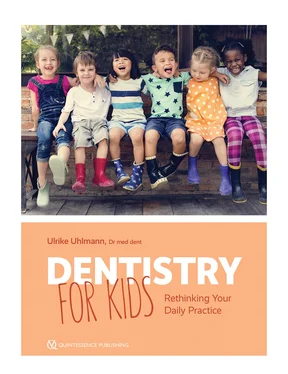Fig 2-3 (a) Demonstrating a brush on daddy. (b) This young patient was able to use the suction and “examine” daddy’s teeth with a little mirror.
It is important not to put pressure on this type of patient and expect too much of them. Investing a little more time at the outset will pay off later. Sometimes two appointments may be necessary to examine these children.
CAUTION
If the parents are anxious patients themselves, it is not advisable to examine the parents by way of example. Overstressing anxious and nervous parents is not productive and tends to create mistrust in the child.
Know-it-alls
These young patients think they know everything about all the treatment steps and like to share their knowledge with the dentist. It can be difficult to sell a syringe to these children as “sleeping medicine.” Sentences such as “I know that’s a syringe and not ‘sleeping medicine’” can easily put the dentist and dental assistant off their stride. It is helpful to reflect the children’s behavior and show off with a foreign word, for instance, saying, “You’re absolutely right, it’s not ‘sleeping medicine’ but anesthesia.” This rebuttal can elicit a suitable reaction from the young patient. The child learns something he or she did not know before, and the dentist remains master of the situation.
Overly spoiled children
The particularly spoiled child is one of the most difficult patients in daily practice. They often confront the dentist petulantly and are defended in their behavior by their parents. Without actually being afraid of the upcoming treatment, they refuse to cooperate. In these cases, dentists can use voice control to their advantage, speaking calmly and more quietly if it is working well. If the child does not cooperate, the dentist speaks more loudly in a more assertive tone of voice. Furthermore, a timed ultimatum can be set during which the child has to go back and sit in the waiting room. If the child entirely refuses to cooperate, a new appointment is made in 2 to 3 weeks. 8Sometimes it may be more advisable to separate the child from the parents for the examination or the treatment.
These children are often raised in anti-authoritarian households with few boundaries and are simply transferring this behavior to the dental practice. The result is a constant testing and challenging, for instance, pressing the buttons on the treatment unit without asking or being disrespectful toward the dentist or practice personnel (“You’re dumb and no way am I going to let you look in my mouth!”). It is important to communicate the rules clearly to these children: “Please listen to me. This is my practice and in here we work by my rules. I’d like you to be nice to me and everyone working here—just as nice as you expect me to be. I cannot keep your teeth healthy if you disrespect me and my helpers and mess with all of my instruments.” These children generally accept these boundaries and usually can be treated without any more difficulty.
Helicopter parents
“Helicopter parents” can make life difficult for you as the dentist, especially if you are fairly young. They are excessively protective of their children, constantly interfering verbally in the treatment, and questioning everything first. This can prevent the dentist from establishing a connection with the child because he or she is continually being distracted by the parent. In this situation, it can be helpful to audibly explain the different chairs in the treatment room to the child and for the parents: “Here we have two special chairs in the room. You can sit on the neat up-and-down chair and your mom can sit on the magic chair there in the corner. That chair magically quiets the voice of whoever’s sitting on it. This means we can talk to each other without being disturbed.” It can also help to give a “strict look” in the direction of the accompanying person who is interrupting. If possible, attempt to separate the parent from their child for the treatment. If the parent will not allow it, an explanatory chat between the dentist and the parent after the treatment may help. Once again, it is useful to guide parents on what to do, either in the form of a letter (see Fig 2-1) or as text on the practice website.
Little tricks from nonverbal behavior management can be useful with very forceful parents. For example, parents can be placed lower down than the dentist on a small seat or stool in the treatment room. This enables the dentist to stay in control of the situation. When greeting parents, the dentist can deliberately move closer within their personal space. This also demonstrates superiority and taking control.
FRONT-OFFICE COMMUNICATION
Communication extends beyond the waiting room and the treatment itself. How the staff approaches scheduling also reflects the positive communication of the practice. Scheduling appointments with patients can occasionally be very difficult. If a practice has newly accepted pediatric patients, this new group of patients can pose entirely new challenges for the practice team. For mothers of babies, arranging and arriving punctually for appointments is undoubtedly a challenge. Flexibility in scheduling and accommodating the realities of life with an infant or toddler will go a long way toward keeping your patients calm and relaxed. Furthermore, morning or early afternoon appointments are generally best for children, but of course they are not always possible because of parents’ working hours. Keeping in mind children’s compliance, however, it is entirely reasonable to give priority to these appointments and communicate that to the parents.
It is also helpful for the front office staff to ask patients to arrive 10 minutes early for appointments. This gives the child some time to get used to the environment, to play a little, and thus to relax. In the meantime, parents can fill out the medical history form or any other necessary documentation. Furthermore, if the staff member garners any personal information when scheduling the appointment with the parents, this can be used for an individual welcome. This creates trust in the child and the parents.
REFERENCES
1.Mostofsky DI, Fortune F. Behavioral Dentistry, ed 2. Ames, IA: John Wiley & Sons, 2014.
2.Müller EM, Hasslinger Y. Sprechen Sie schon Kind?: Prophylaxe auf Augenhöhe. Berlin: Quintessenz, 2016.
3.Kossak HC, Zehner G. Hypnose beim Kinder-Zahnarzt. Verhaltensführung und Kommunikation. Heidelberg: Springer, 2011.
4.Atzlinger F. Kinderhypnose in der Zahnheilkunde. Diplomarbeit. Universität Budapest, Fakultät für Zahnmedizin, 2008. http://www.zahn1.at/service/downloads?file=files/assets/content/Download/DiplomarbeitKinderhypnoseinderZahnmedizinges.pdf. Accessed 26 August 2017.
5.Goho C. „Top 10“ der Fehler im Umgang mit kleinen Patienten. ZWP online, 28.02.2011. http://www.zwp-online.info/zwpnews/wirtschaft-und-recht/patienten/top-10-der-fehlerim-umgang-mit-kleinen-patienten. Accessed 26 October 2018.
6.Zehner G. (Hrsg.) Quick Time Trance und Hypnopunktur, 2004. http://www.kinderzahnarzt-praxis.info/app/download/5872895961/QuickTimeTrance+und+Hypnopunktur.pdf?t=1359880533. Accessed 2 December 2016.
7.Goho C. Die erfolgreiche Behandlung von Kindern. ZMK 2011;27(12):778-782. http://www.zmk-aktuell.de/fachgebiete/kinderzahnheilkunde/story/die-erfolgreiche-behandlung-von-kindern_595.html. Accessed 2 December 2016.
8.Goho C. Erfolge und Misserfolge in der Kinderzahnheilkunde; Fortbildungsveranstaltung der LZÄK Sachsen, Dresden, 2011.
3EDUCATING PARENTS: ORAL HYGIENE AND PROPHYLAXIS
“The older the children, the greater the worries.”
ANONYMOUS
This chapter briefly addresses issues that, based on experience, frequently preoccupy parents and which they often ask about in the explanatory discussion with their dentist. First and foremost among these is oral hygiene and prophylaxis. Parents want to know what they should be doing to prevent caries. That being said, not all parents are as motivated as the next, so we as pediatric dentists need to do our best to advocate for the oral health of our young patients.
Читать дальше












